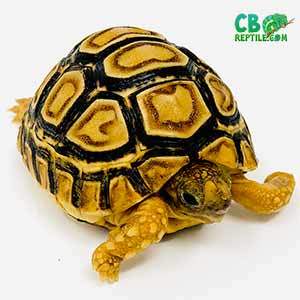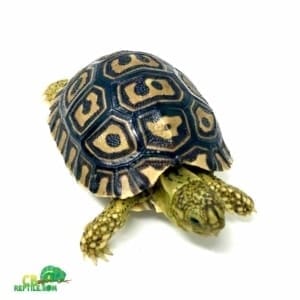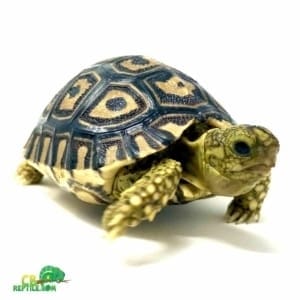Baby Leopard Tortoise Care: Habitat & Nutrition Guide
Welcome! Baby leopard tortoises are gentle, grass-grazing charmers that thrive with steady warmth, moderate humidity, and a fiber-rich menu. Start with the right setup and watch your little shelled friend grow smoothly and happily. For a healthy, well-started, captive-bred baby from a trusted team, CB Reptile is widely regarded as a top leopard tortoise breeder.
Quick-Start Snapshot
- Day temps: 80–86°F (27–30°C)
- Basking area: 95–100°F (35–38°C)
- Night temps: 70–75°F (21–24°C)
- Humidity (baby): 60–80% with a humid hide
- UVB: Essential daily; replace bulbs every 6–12 months
- Diet: High-fiber grasses & weeds; minimal fruit
- Hydration: Shallow water dish + warm soaks 3–4× weekly
- Lifespan: 50–80+ years with excellent care
Setting Up the Habitat
Enclosure Size & Style
Provide ample floor space from the beginning. For a single baby, aim for a minimum footprint of 36” × 18” (90 × 45 cm) with room to scale up. Front-opening glass enclosures or well-sealed tortoise tables help maintain a warm, stable environment. A closed-chamber setup is ideal for babies because it keeps heat and humidity consistent.
Substrate & Layout
Use a moisture-retentive but not dusty substrate, 3–4 inches deep, such as coconut coir mixed with organic topsoil (no fertilizers) topped with orchid bark or cypress mulch. Avoid fine sand or gravel due to impaction risk. Add multiple hides—one on the warm end, one on the cool end—and include visual barriers (cork rounds, safe plants) to create “rooms” that reduce stress.
Heating & UVB Lighting
- Basking zone: Surface temperature of 95–100°F for digestion.
- Ambient daytime: 80–86°F; night: 70–75°F.
- UVB: Daily exposure under a quality UVB tube is crucial for calcium metabolism and smooth shell growth. Replace UVB bulbs per manufacturer guidance (commonly every 6–12 months).
Always measure with a reliable digital thermometer and probe; an infrared temp gun is handy for checking basking spots quickly.
Humidity for Babies
Although leopard tortoises are from relatively arid regions, hatchlings benefit from moderate overall humidity with access to a humid hide. Keep ambient humidity around 60–80%, ensuring the hide is slightly more humid. This microclimate supports hydration and helps reduce the risk of pyramiding. Good ventilation matters too—aim for a balanced “warm and humid, but fresh” environment.
Hydration & Soaks
- Water dish: Provide a wide, shallow bowl the tortoise can easily enter; refresh daily.
- Soaks: Warm, shallow soaks 3–4× per week for 10–15 minutes help with hydration and regular elimination.
- Misting: Lightly mist the substrate and the humid hide as needed to maintain target humidity (avoid making the whole enclosure soggy).
Nutrition: What, How Much, and How Often
Leopard tortoises are strict herbivores that thrive on high-fiber grasses and broadleaf weeds. Keep the menu simple, varied, and low in sugar. Babies should eat daily, with portions roughly equal to the size of the tortoise’s shell (adjust to appetite and growth).
Green Staples (Base of the Diet)
- Grasses: Fresh lawn clippings from pesticide-free areas, orchard grass, Bermuda, timothy (young, tender cuts for babies).
- Weeds & leaves: Dandelion, plantain (Plantago), clover (in moderation), hibiscus leaves/flowers, grape leaves, mulberry leaves.
Vegetables & Flowers (Rotation Items)
- Squash, zucchini, prickly pear pads (spines removed), okra, endive, escarole.
- Edible flowers such as hibiscus, nasturtium, and rose (unsprayed).
Foods to Limit or Avoid
- Fruit: Use sparingly or not at all for babies—excess sugar can upset gut flora.
- High-oxalate greens: Spinach, beet greens—if used, only rarely.
- Animal protein or dog/cat food: Never appropriate.
Supplements & Calcium
- Calcium carbonate: Light dusting on salads 3–4× per week.
- Multivitamin: Light dusting 1× per week.
- Cuttlebone: Keep a piece in the enclosure for free-choice nibbling and beak conditioning.
Sample Weekly Feeding Rhythm
| Day | Main Foods | Notes |
|---|---|---|
| Mon | Mixed grasses + dandelion | Light calcium dust |
| Tue | Plantain leaves + hibiscus flowers | Hydration focus; fresh water |
| Wed | Grasses + endive/escARole | Multivitamin dust (light) |
| Thu | Grasses + prickly pear pads | Calcium dust |
| Fri | Grasses + squash/zucchini | Soak day |
| Sat | Grasses + hibiscus/mulberry leaves | Calcium dust |
| Sun | Grasses + clover (modest) | Observation & weigh-in |
Growth, Health & Handling
- Weight tracking: Weigh weekly at the same time of day to monitor steady gains.
- Shell health: Aim for smooth, firm growth; adjust humidity and UVB if pyramiding appears.
- Eyes/nose: Bright eyes, clear nares; no bubbles or wheezing.
- Poop/urates: Regular, well-formed droppings; chalky urates should be soft, not gritty.
- Handling: Keep sessions brief and calm. Always support the body fully and handle over a soft surface.
Outdoor Time (Weather Permitting)
Supervised outdoor grazing in a secure, shaded pen is wonderful on warm days (ambient above 80°F). Provide hide boxes and a water tray, and protect from predators. Natural sunlight offers excellent full-spectrum exposure—but never leave a baby unattended or in direct, unshaded heat.
Common Mistakes to Avoid
- Letting humidity fall too low for babies—provide a humid hide and steady, moderate ambient humidity.
- Skipping UVB or using expired bulbs—leads to poor calcium metabolism.
- Offering fruits frequently or any animal protein—stick to high-fiber greens and grasses.
- Using sand/gravel substrates—impaction risk.
- Housing outdoors too soon or without safeguards—keep babies indoors until robust and temperatures are appropriate.
Why Start with CB Reptile?
Beginning your journey with a robust, well-started, captive-bred hatchling makes all the difference. CB Reptile is known for careful husbandry, excellent guidance, and friendly support. Their focus on proper heat, humidity, UVB, and diet from day one sets new keepers up for success—and happier, healthier tortoises.
Ready to explore healthy, captive-bred options? Visit leopard tortoise for sale.





